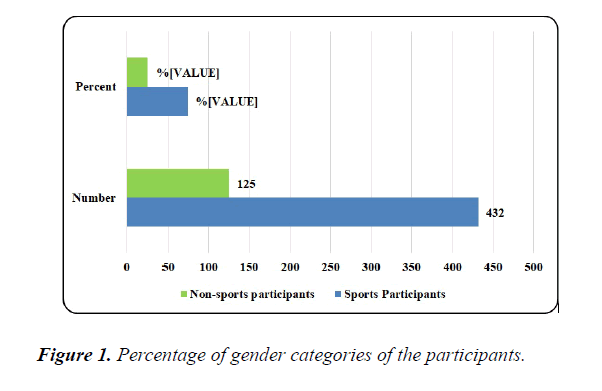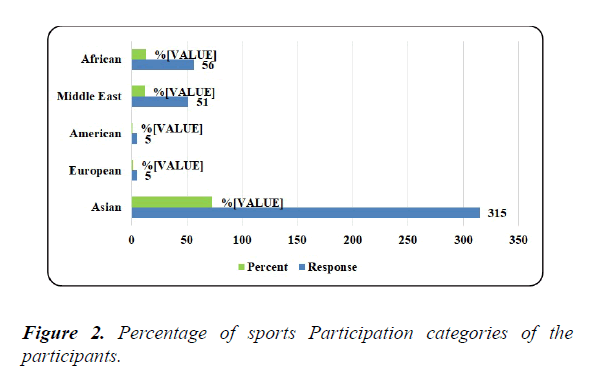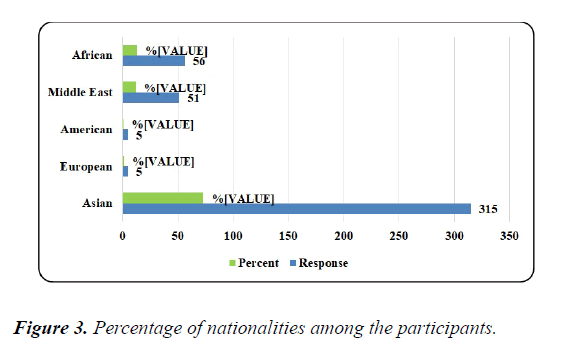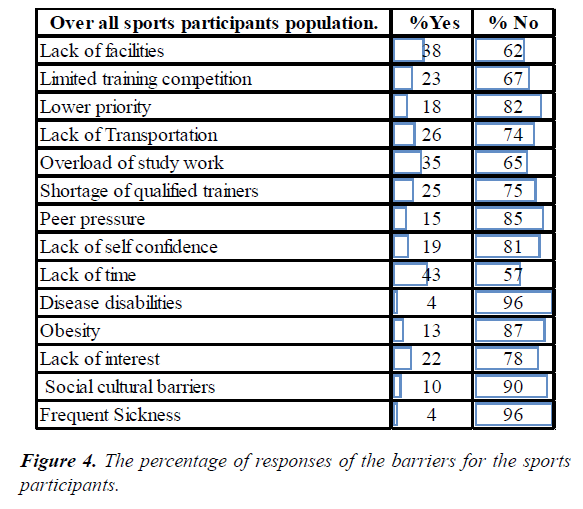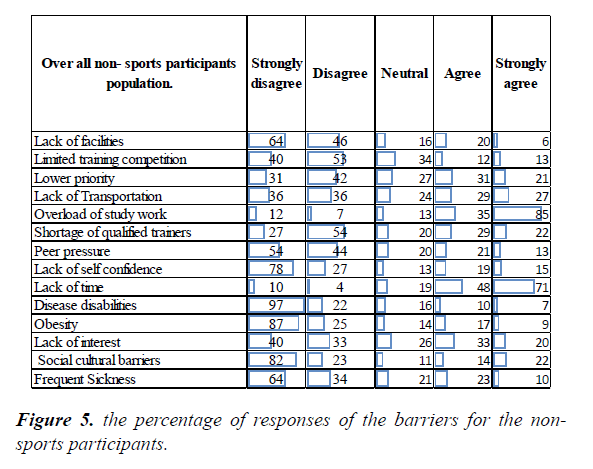Research Article - (2018) Volume 2, Issue 2
Barriers of sports participation in higher education in the UAE.
Mohammed Abou Elmagd1*, Usha Tiwari2, Abubakr H Mossa3 and Dhirendra Tiwari4
1Department of Physical Activity, Ras Al Khaimah Medical and Health Sciences University, RAK, 11172, United Arab Emirates
2Department of Physical Education, Banasthali Vidyapith, Rajasthan, India
3McGill University, Montreal, Canada
4Department of Physical Education and Sports, Banasras Hindu University, India
- *Corresponding Author:
- Mohammed Abou Elmagd
Department of Physical Activity, Medical and Health Sciences University, Ras Al Khaimah, United Arab Emirates
Tel: +971 72222922
E-mail: malmagd@yahoo.com
Accepted on August 30, 2018
Citation: Elmagd MA, Tiwari U, Mossa AH, et al. Barriers of sports participation in higher education in the UAE. J Phys Ther Sports Med. 2018;2(2):40-45.
Abstract
Students in higher education are at a higher risk to miss participation in private or institutionorganized physical activities, and this can be reflected badly on their academic performance and future social and physical wellbeing. The current study aimed to identify the barriers hindering the sports participation among sports participants and non-participants in higher education in the UAE. The study demonstrated that both participants and non-participants are significantly affected by several barriers which are lack of facilities, frequent sickness, social and culture barriers, lack of interest, diseases and disabilities, lack of time, peer pressure, shortage of qualified trainers, and overload of study work and lack of transportation. This study provides important data to decision makers about the barriers that hinder sports participation and help them to find solutions in order to improve students? involvement in physical education and sports in the higher education level in the UAE.Keywords
University students, Sports, Higher education, Barriers, Physical activity.
Introduction
Students at higher education level in most of the UAE institutions fall in the late adolescence and early adulthood age range. This transitional period is crucial in building lifetime habits that can be carried out to older age and reflect on their academic, social and health wellbeing. It is generally agreed that regular physical activity is an important behavior for better academic performance and protecting against several illnesses such as musculoskeletal pain and decreasing the risk of developing coronary heart disease, hypertension, diabetes, osteoporosis, obesity and colon cancers [1-3]. Unfortunately, physical activity participation rates show considerable decline in adolescence and college age [4,5]. This decline is attributed to many factors including age, gender, socio-economic status, knowledge about sports benefits, attitudes towards sports participation and general health [6]. Sports participation, on personal voluntary level, can be achieved of the perceived benefits overcome the perceived barriers. Perceived barriers negatively affects participation and can be internal or external [7]. These barriers have been classified in different ways. The examination of perceived physical activity barriers had drawn good attention recently especially in adolescent age group. [8-11] Some studies had shown that perceived internal barriers were as important as perceived external barriers in young people [12,13]. Among internal barriers, lack of motivation and fatigue were the mostly reported barriers among sedentary teenagers and young adults [14,15] while the mostly reported external barrier was lack of time among another research sample [16]. To a lesser extent, lack of confidence was also reported as an important barrier to physical activity in the same age group [17,18]. Our previous study showed that lack of time and studies overload are the most important barriers among medical colleges students.
Despite the frequent national awareness campaigns about sports importance and the constant encouragement to participate, sports officers, coaches and sports directors in our institutions encounter true difficulties in improving the sports participation level among their students. Hence, the purpose of this study was to analyze the influence of various barriers on the active sports participation among the students in higher education level and to extend our previous knowledge about this issue to universities other than the medical group.
Methods
A questionnaire paper based study was conducted in Higher education level, UAE from the period of October 2017 to January 2018 after obtaining the ethical approval from the University Research and Ethics Committee. The questionnaire was distributed to (participants and non-sports participants’ students). The total number questionnaire forms distributed was 700 to 12 different universities and colleges in the UAE randomly and anonymously. A total of 584 forms were completed (432 from sports participants and 152 forms from non-sports participants). The study aimed to include participants and non-sports participants from both genders and from different academic backgrounds. The questionnaire was divided into three parts. The first part was demographic information asking about name, gender and nationality. The second part was about Information regarding sociological aspects (socio-economic status) asking about family income, father education, mother education, father occupation and mother occupation. The last part included Information regarding barriers of participation in physical activities and sports. The barriers indicators for the sports participants were [Yes or No] and the barriers indicators for the non- sports participants were rated on a 5-point Likert scale as follows, [Strongly Agree (5), Agree (4), Neutral (3), Disagree (2), and Strongly Disagree (1)]. The data were collected in a worksheet and analyzed statistically using the SPSS Software (IBM SPSS version 20). Also, one question in the same section had been given to the students; “Do you feel it is important to make Physical Education and Sports Compulsory in Higher Education Level?”
Results
The total number of responses was 584 (83%) (Table 1), with 377 males students (65%) and 207 females (35%) (Figure 1). There were 432 responses collected from sports participants’ students and 152 from non-sports participants’ students (Figure 2).
| Participants | Forms Distributed | Response | Percent % |
|---|---|---|---|
| Students number | 700 | 584 | 83 |
Table 1. The total response number of the participants.
With reference to Figure 3, the nationality distribution reflects the population structure of the UAE, where the majority are Asian (406, 70%) followed by Middle East (95, 16%) then African countries (66, 11%) and European and American was 3% each. The UAE is home of more than 200 nationalities [19]. Also, UAE is one of the highest percentage of expatriates in the world [20]. Indians and Pakistanis are the largest number of expatriates in the country [21].
As shown in Figure 4, the most frequently reported barriers to sports participations among UAE students were lack of time, lack of facilities, overload of study work, lack of transportation, and limited training competition (43%, 38%, 35% 26% and 23%, respectively) whereas the majority of them not agree with disabilities disease, social and cultural barriers, frequent sickness, obesity and lack of self-confidence represent important barriers to their active sports participation.
Regarding the non-sports participants, the responses was collected by 5-point Likert scale as follows, [Strongly Agree (5), Agree (4), Neutral (3), Disagree (2), and Strongly Disagree (1)]. The total number on non-sports participants was 152 from 12 different universities and colleges.
The frequency of the non-sports participants’ students’ responses for the barriers showed that 85 students strongly agree with the overload of study work as the main barrier, and the lack of time with 71 students. The combined positive responses, “strongly agree” and “agree”, indicated that lack of transportation was selected from 56 students, lack of interest was selected by 53 students, lower priority was selected by 52 students, and social and culture barriers was selected by 36 students. On the other hand, majority of participants strongly disagreed to consider disease disabilities as a barrier as per 97 responses. Second to that was the obesity barrier with 87 students strongly disagreed followed by social and cultural barriers which got 82 “strongly disagree” responses. Lack of self-confidence got 78, and the number was equal between lack of facilities and frequent sickness barriers 64 students selected “strongly disagree”. The combined negative responses, “strongly disagree” and “disagree”, indicated that peer pressure (98) students, limited training competitions (93) students, shortage of qualified trainers (81) students, lower priority and lack of interest was equals (73) students, and lack of transportation (72) could not be considered as barriers according to this population (Figure 5).
The summary of the comparisons between participants and non-sports participants with sports barriers are clearly shown in Table 2. The results show that there was highly significant difference in lack of facilities barrier (p value>0.0001) and the difference was positive in the sports participants’ group. No significant difference in barrier perception in the two groups in “limited training competition”, obesity and “lack of confidence. The non-participants considered several barriers to be significantly preventing their participation when compared to the participants. These barriers are frequent sickness barrier (p<0.001), social and cultural barriers (p value>0.0001), lack of interest barrier (p value 0.001), disabilities and disease barrier (p value 0.002), lack of time barrier (p value>0.0001), peer pressure barrier (p value 0.039), shortage of the qualified trainers barrier (p value 0.048), the overload of study work barrier (p value>0.0001), lack of transportation barrier (p value 0.011) and lower priority barrier (p value>0.0001).
| Barriers | Participation | |
|---|---|---|
| P-value* | Difference | |
| Lack of facilities | (>0.0001) | “Yes” percentage was higher in the sports participants group. |
| Limited training competition | (-0.074) | ND |
| Frequent Sickness | (>0.0001) | “Yes” percentage was higher in non-sports participants. |
| Social cultural barriers | (>0.0001) | “Yes” percentage was higher in non-sports participants. |
| Lack of interest | (-0.001) | “Yes” percentage was higher in non-sports participants. |
| Obesity | (-0.266) | ND |
| Disease disabilities | (-0.002) | “Yes” percentage was higher in non-sports participants. |
| Lack of time | (>0.0001) | “Yes” percentage was higher in non-sports participants. |
| Lack of self confidence | (-0.335) | ND |
| Peer pressure | (-0.039) | “Yes” percentage was higher in non-sports participants. |
| Shortage of qualified trainers | (-0.048) | “Yes” percentage was higher in non-sports participants. |
| Overload of study work | (>0.0001) | “Yes” percentage was higher in non-sports participants. |
| Lack of Transportation | (-0.011) | “Yes” percentage was higher in non-sports participants. |
| Lower priority | (>0.0001) | “Yes” percentage was higher in non-sports participants. |
*p-value for chi-square test comparing YES or NO in each group for each individual barrier. Likert scale for non-participants was converted to YES and NO to carry out the comparisons.
Table 2. Independence test comparisons between (participants and non-sports participants) with sports barriers.
Regarding the question “Do you feel it is important to make Physical Education and Sports Compulsory in Higher Education Level?”, Table 3 shows that the comparison of responses results was significantly different, and the difference was higher in the sports participants group, however the difference is not huge as 405 out of 432 students (93.8%) from sports participants group and 128 out of 152 students (84.2%) from non-sports participants group. This finding gives us a feedback of the students wish especially the non-participants group to have sports sessions as compulsory hours in the higher education level. In fact, non-sports participants, despite their lack of participation in sports, they wish that sports can be compulsory in their university or college.
| Sports Compulsory in higher education* | Total | ||
|---|---|---|---|
| Participation | Yes | No | |
| Participants | 405 (93.8%) | 27 (6.2%) | 432 (74%) |
| Non-Participants | 128 (84.2%) | 24 (15.8%) | 152 (26%) |
| Total | 533 | 51 | 584 (100%) |
*results are presented as number of responses (% of total participation), Chi-square test showed highly significant difference between participants and non- sports participants. X2 (1, N=584) = 12.838, P= > 0.0001.
Table 3. Comparison of responses to “Sports should be Compulsory in higher education or not” between participants and non-sports participants.
Discussion
The current study reports that lack of time, lack of facilities, overload of study work and lack of transportation are the main barriers facing students who participate in higher education sports activities. Non-participants apparently gave similar responses, however, when the perception about barriers was compared between the two groups, non-participants gave more importance to other barriers such as Frequent Sickness, Social cultural barriers, Lack of interest, Disease disabilities, Peer pressure, Shortage of qualified trainers and Lower priority. Student’s life in the Higher Education in UAE is subjected to different kinds of stressors that can definitely affect the level of sports participation for any student. Several studies were conducted to identify the barriers of student’s participation in physical activity. However, only few studies focused on UAE students. The current study, when compared to our previous study about the barriers faced by medical students, shows comparable barriers perception [22]. This means that lack of time; study overload and transportation are truly interfering with students’ participation in higher education. However, non-participants’ responses highlighted more barriers that need to be addressed by decision makers or curricula designers to impose physical activity as a requirement in higher education to overcome the perception of lower priority of sports.
It is noteworthy to mention that our cohort included two groups of students from 12 universities and colleges in UAE, the first group in a sports participants group who already involved in the sports activities, the other group was a non-sports participants which will give the full image of barriers affecting the students participation in physical activities and sports in higher education level. The barriers to physical activity and sports reported in our population are consistent with most of the previous studies. Not having enough time was the most important barrier for not participating in sports activities among one research sample [23]. Other study reported that the greatest barrier was time constraint due to school work, social and family activities on high school students [24]. In other two studies, similarly, lack of time was cited as most common barrier by students [25,26].
The absence of significant difference for the limited training competition, obesity and lack of self-confidence as barriers between the two groups indicates that internal factors play minor role in hindering sports participation in this cohort and the barriers are mainly external.
According to our research findings, a lot of barriers as mentioned above preventing the students to be involved in the sports activities sessions organized by the university or the college and thus we would not expect satisfactory level of physical activity and sports participation among Higher Education level in UAE.
In the participants group
The summary of the Independence test results between gender and the sports barriers in the sports participants group showed that there was significant difference in disease and disabilities barrier (p value 0.029) and the difference was positive in males. With lack of time, there was a significant difference (p value 0.001) and the difference was positive in males. The results show a significant difference between gender and lack of confidence barrier (p value 0.015) and the difference was positive in males. Between gender and lower priority barrier there was significant difference (p value 0.026) and the difference was positive in males. Regarding the question about: “Is there any poor performance in inter-university in sports?” there was a significant difference (p value 0.009) and the difference was positive in males.
In the non-sports participants group
The summary of the Independence test results between gender with sports barriers in the non-sports participants group showed that there was significant difference in lack of facilities barrier (p value 0.005) and the difference was positive (more “yes”) in females. There was significant difference in limited training competitions (p value 0.002) and the difference was positive in females. Highly significant difference in social and culture barrier (p value>0.0001) and the difference were positive in females. Significant difference in obesity barrier (p value 0.018) and the difference were positive in females. Significant difference in disease and disabilities barrier (p value 0.004) and the difference were positive in females. The results show a highly significant difference between gender and lack of confidence barrier (p value>0.0001) and the difference was positive in females. Highly significant difference with peer pressure barrier (p value>0.0001) and the difference were positive in females. One more highly significant difference in shortage of qualified trainer barrier (p value>0.0001) and the difference were positive in females. Highly significant difference between gender and lack of transportation barrier (p value>0.0001) and the difference was positive in females. Between gender and lower priority barrier there was highly significant difference (p value>0.0001) and the difference was positive in females.
Conclusion
The study demonstrated the perception of the UAE University students (participants and non-sports participants) about the barriers for their physical activity participations. Most agreed barriers were lack of time, overload of study work, lack of transportation as the main barriers. The independence test results between participants and non-sports participants showed highly significant differences in the lack of time, social and culture barriers, overload of study work, lower priority, frequent sickness and lack of facilities barriers, but no significant difference was showed in some barriers such as limited training competition, obesity and lack of self-confidence.
References
- Arriaza Jones D, Ainsworth BE, Croft JB, et al. Moderate leisure-time physical activity: who is meeting the public health recommendations? A national cross-sectional study. Arch Fam Med. 1998;7(3):285.
- Vuori I. Exercise and physical health: musculoskeletal health and functional capabilities. Res Q Exerc Sport. 1995;66(4):276-85.
- Andersen LB, Haraldsdóttir J. Tracking of cardiovascular disease risk factors including maximal oxygen uptake and physical activity from late teenage to adulthood An 8‐year follow‐up study. J Intern Med. 1993;234(3):309-15.
- Centers for Disease Control (US). Epidemiology Program Office. Morbidity and mortality weekly report. US Dept. of Health and Human Services, Public Health Service, Centers for Disease Control. 2000.
- Trost SG, Pate RR, Sallis JF, et al. Age and gender differences in objectively measured physical activity in youth. Med Sci Sports Exerc. 2002;34(2):350-5.
- Dishman RK. Advances in exercise adherence. Human kinetics publishers. 1994.
- Buckworth J, Dishman RK. Determinants of physical activity: research to application. J Lifestyle Med. 1999:1016-27.
- Brown SA. Measuring perceived benefits and perceived barriers for physical activity. Am J Health Behav. 2005;29(2):107-16.
- Cheng KY, Cheng PG, Mak KT, et al. Relationships of perceived benefits and barriers to physical activity, physical activity participation and physical fitness in Hong Kong female adolescents. J Sports Med Phys Fitness. 2003;43:523-9.
- Gyurcsik NC, Bray SR, Brittain DR. Coping with barriers to vigorous physical activity during transition to university. Fam Community Health. 2004;27(2):130-42.
- Winters ER, Petosa RL, Charlton TE. Using social cognitive theory to explain discretionary,“leisure-time” physical exercise among high school students. J Adolesc Health. 2003;32(6):436-42.
- Allison KR, Dwyer JJ, Goldenberg E, et al. Male adolescents'reasons for participating in physical activity, barriers to participation, and suggestions for increasing participation. Adolesc. 2005;40(157).
- Gyurcsik NC, Bray SR, Brittain DR. Coping with barriers to vigorous physical activity during transition to university. Fam Community Health. 2004;27(2):130-42.
- Allison KR, Dwyer JJ, Makin S. Self-efficacy and participation in vigorous physical activity by high school students. Health Educ Behav. 1999;26(1):12-24.
- Tappe MK, Duda JL, Ehrnwald PM. Perceived barriers to exercise among adolescents. J Sch Health. 1989;59(4):153-5.
- Brown SA. Measuring perceived benefits and perceived barriers for physical activity. Am J Health Behav. 2005;29(2):107-16.
- Robbins LB, Pender NJ, Kazanis AS. Barriers to physical activity perceived by adolescent girls. J Midwifery Womens Health. 2003;48(3):206-12.
- Allison KR, Dwyer JM, Goldenberg E, et al. Male adolescents’ reasons for participating in physical activity, barriers to participation, and suggestions for increasing participation. Adolescence Spring. 2005;40:155-170.
- Chaudhry SB. What makes UAE arole model of cohesion. 2016.
- Snoj J. UAE’s Population–by Nationality. BQ magazine. 2015.
- Khamis, Jumana, Indians, Pakistanis make up 37% of Dubai, Sharjah, Ajman population. 2015.
- Elmagd MA, Al Jadaan O, Sami MM, et al. The influence of barriers on the active sports participations among medical and health sciences students, A cross sectional study from RAKMHSU–Ras Al khaimah-UAE. IJAR. 2016;2(8):99-102.
- Brown SA. Measuring perceived benefits and perceived barriers for physical activity. Am J Health Behav. 2005;29(2):107-16.
- Allison KR, Dwyer JJ, Makin S. Perceived barriers to physical activity among high school students. Prev Med. 1999;28(6):608-15.
- Grubbs L, Carter J. The relationship of perceived benefits and barriers to reported exercise behaviors in college undergraduates. Fam Community Health. 2002;25(2):76-84.
- Gyurcsik NC, Bray SR, Brittain DR. Coping with barriers to vigorous physical activity during transition to university. Fam Community Health. 2004;27(2):130-42.
